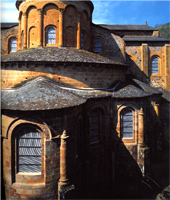Conques basilica, Aveyron FLEURY / SOULAGES
Introduction
Fleury’s first collaboration with an established contemporary artist was with Pierre Soulages who is world renowned for his pictorial work on noir-lumière. The Romanesque basilica at Conques was the subject of a State funded commission for historical monuments. Fleury’s mission was to translate Soulages’ vision into 104 stained glass windows.
The realisation of this project took three years. Their joint talents have succeeded in resurrecting this site. It has been transformed by the new light and life that the stained glass windows have brought to the basilica. Having received much media acclaim, Conques also attracts millions of visiters. 10 centuries after the pilgrimages to Santiago de Compostella, the basilica at Conques has in some ways, become the focus for a new cult.
THE MATERIAL
For light to issue from the glass itself and not come directly from the sun, the glass used at Conques is not transparent, but translucent. The diffused quality of light transmission isolates the space within the basilica, cutting it off from the outside world, giving rise to inner reflection. Externally, they blend with the stone whose chromatic uniformity is not disrupted by the mottled glass.
Specially created in a laboratory using granulation technique, differing levels of crystalisation throughout the glass create nuances of diffused light. Each sheet of glass is approximately 8 millimeters thick.
THE METHOD
An intrinsic knowledge of the material, a sound capacity for listening, but also a real intuition for bringing a vision to fruition; these are the qualities that are needed in order for a collaboration to run smoothly. For those who work at the Jean-Dominique Fleury Studio and who worked alongside Pierre Soulages, the demands made were many and varied. They had to learn new techniques and new gestures, they had to alter their methods, they had to invent and use new tools.
The originality of the project necessitated the building of full-scale models of the windows before work on the glass could begin. Strips of black tape were patiently placed on large wooden panels to indicate the future placement of lead and iron bar whose lines would give the stained glass windows their form. Equally, these demands enabled Jean-Dominique Fleury to extend the historical practice of the stained glass artist, to embrace and develop the project, and to demonstrate his expertise at all stages from the preliminary sketches to the final execution.







